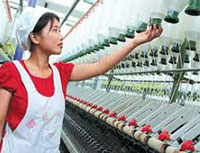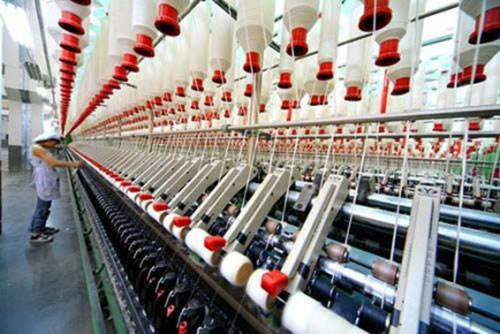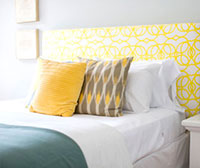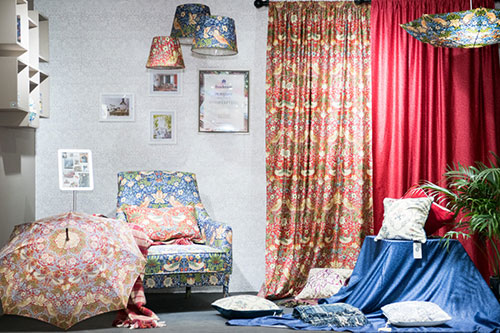FW
"Official statistics released by the China Customs reveal the textile manufacturing sector is going through an intense transformation. Few years ago, many garment factories in China refused to manufacture less than 1,000 pieces of clothing on a single model. These factories also calculated their profit margins based on the massive manufacturing orders and low labor costs. However, now brands are becoming more mature and rational."
 Official statistics released by the China Customs reveal the textile manufacturing sector is going through an intense transformation. Few years ago, many garment factories in China refused to manufacture less than 1,000 pieces of clothing on a single model. These factories also calculated their profit margins based on the massive manufacturing orders and low labor costs. However, now brands are becoming more mature and rational. They are gearing up to take stock of the rising mall rentals, increasing labor costs and the expense of maintaining an unsold inventory.
Official statistics released by the China Customs reveal the textile manufacturing sector is going through an intense transformation. Few years ago, many garment factories in China refused to manufacture less than 1,000 pieces of clothing on a single model. These factories also calculated their profit margins based on the massive manufacturing orders and low labor costs. However, now brands are becoming more mature and rational. They are gearing up to take stock of the rising mall rentals, increasing labor costs and the expense of maintaining an unsold inventory.
US-based Forever 21 officially exited from the market in May, 2019 while Meters/bonwe, a Chinese fashion brand established by a Zhejiang entrepreneur, closed 1,500 stores over the past three years. The brand had reported losses worth 150 million RMB for the first half of 2019.
brand established by a Zhejiang entrepreneur, closed 1,500 stores over the past three years. The brand had reported losses worth 150 million RMB for the first half of 2019.
Manufacturing becomes factory-owned
The current situation offers Chinese companies an opportunity to upgrade their products and embrace innovation to remain relevant. China’s textile manufacturing sector is experiencing a structural transformation as many fashion companies are shifting manufacturing from Original Equipment Manufacturers (OEMs) into Original Design Manufacturer (ODMs). This type of manufacturing involves the factory in the research, design, concept and engineering of its clothes. These factories also attach the buyers' label on these garments.
Many factories in the Zhejiang province have transformed their manufacturing model by establishing factory-owned independent brands. These brands are exploring marketing and sales on a variety of e-commerce platform rather than relying solely on mall sales.
Need to strengthen textile reforms
Although China was the first country to pass the water protection regulation in 1988, it made the enforcement of this water protection legislation a priority only recently. Its Ministry of Ecology and Environment drafted the ecological criteria entitled The Standard of Water Waste Emissions for the Textile Industry only recently.
Textile factories in the country are also adopting high-tech automation hybrid with traditional production systems to concentrate on "cleaning up" the dyeing process. Similarly, factories in Shandong, Guangdong and Hunan are improving their water management, since International Finance Corporation (IFC) launched the China Water Program in 2012. However, there is a strong need to deepen these reforms in the Chinese textile industry.
As a part of Shanghai Fashion Week, Kering and global innovation platform Plug and Play held the first K Generation Talk & Award Ceremony. They recognised three Chinese startups, Melephant, Heyuan and FeiLiu Technology for their disruptive innovations addressing sustainability challenges in the textile value chain.
The K Generation Award was launched in December 2018 to recognise and support Chinese startups who can bring about positive environmental and social impact in alternative raw materials, green supply chain, retail & use and the circular economy.
Melephant, the first awardee and winner of a €100,000 grant, provides natural dyes from organic waste in a circular, no-waste system. Second awardee, Heyuan has an innovative water treatment technology for printing and dyeing. Third awardee, FeiLiu Tech offers supply chain optimisation through AI that allows for small batch runs to avoid over production.
From December 2018 to August 2019, under the leadership of Marie-Claire Daveu, Kering’s Chief Sustainability Officer and Head of International Institutional Affairs, many Chinese startups participated and put forward their own sustainable innovation projects. 50 startups were examined in detail to arrive at the final three winners selected by a jury of leading industry figures in the fields of fashion, luxury, entrepreneurship, sustainability and innovation.
Outland Denim-the Australia-based brand recently opened a new stand-alone 23,600-square-foot wash and finishing facility in Phnom Penh, Cambodia, taking its production capabilities to the next level.
Beginning with Outland Denim’s Fall/Winter ’19 collection, jeans will now be washed, whiskered and aged using the facility’s state-of-the-art water and energy-reducing technology by Jeanologia.
Laser finishing removes the need for water-intensive washing and heavy chemical use. Ozone technology uses up to 65 percent less water, 20 percent less energy and 80 percent less chemical use than standard approaches. And e-flow technology transfers wash recipes onto jeans with up to 95 percent less water, 40 percent less energy and 90 percent less chemicals than traditional techniques.
The new facility adds a new layer to Outland’s sustainable manufacturing. Outland uses vegetable dyes, organic dyes and dyes tested for harmful chemicals in all production to combat further human and environmental threats from the use of toxic synthetic indigo dyes.
Coloreel will introduce the innovative Coloreel unit at the show Printing United in Dallas, 23-25 October 2019. The brand will exhibit at Hirsch Solutions stand 2200 and present the USA market as the next big thing of the embroidery industry.
The first product to be showcased based on the Coloreel technology includes a groundbreaking thread coloring unit that works with any existing industrial embroidery machine. By instantly coloring a white base thread during the embroidery production, Coloreel enables complete freedom to create unique embroideries without any limitations in the use of colors.
The Printing United show will display the latest solutions for apparel, graphics/wide-format and functional printing applications, while also extending into the commercial, packaging, and in-plant printing segments.
The USA market covers the whole spectra of the embroidery industry with companies in both fashion and sport. The entire USA market is about 85-90 per cent of the whole European market and it contains a lot of single head embroidery machines. The USA market has come far in the personalisation trend, which is growing globally.
Global yarn production increased by 17 per cent between the final quarter of 2018 and the first quarter of 2019.
Higher output levels were observed in Asia, Brazil, the US and Europe. There was a 27 per cent increase in Chinese yarn production. Global fabric production increased by 3.8 per cent. Global fabric stock levels stagnated.
Global yarn stocks increased by 6.3 per cent worldwide. This results from a 27 per cent improvement in Egypt, a 7.7 per cent raise in Brazil, and a 3.8 per cent increase in Asia. The latter is the consequence of stock growth in Japan and India, stability in Pakistan and decrease in Korea, and Chinese Taipei. Altogether, yarn stocks reached 97 per cent of their previous year’s level for the same quarter. Global yarn orders increased by 12 per cent led by Brazil, Egypt and Asia. In first quarter of 2019, global fabric stocks were one per cent above their first quarter of 2018. Global fabric orders dropped by 19 per cent in the first quarter of 2019, led by a decrease of 32 per cent in Egypt and 25 per cent in Brazil. Global fabric orders were eight per cent above their 2018 level.
Global alternative asset manager Investcorp, invested $11.2 million in Bewakoof Brands - one of the leading direct to consumer online apparel companies in India. The brand provides creative and distinctive fashion at affordable prices for trendy and contemporary Indians.
Bewakoof was founded by Prabhkiran Singh and Siddharth Munot in 2011. Since inception, it has created fashion which resonates with millennials across India and has been widely recognised for its unique designs. In a short period of time, it has created a robust brand offering by building strong capabilities in design, supply chain and a high engagement digital customer platform. This has led to delivering sales of more than 650,000 products per month with a customer base of over 4 million, often making repeat purchases.
Investcorp’s investment in Bewakoof is in line with their strategy to tap into sustainable business models in the mass consumption driven Indian market. Investcorp raised `1,000 crore in its maiden India-focused private equity fund. The new fund targets investment opportunities across three key sectors – mass-market consumer, financial services and healthcare. Other than Bewakoof, the fund has so far invested in four companies namely Incred, ASG, Zolo and Citykart.
Investcorp manages over $28 billion globally and at its core is a mid-market investment specialist. The private equity business of Investcorp has close to 40 years of mid-market investing experience across the North America, Europe and the MENA region with more than $36 billion of transaction value in almost 200 investments across retail, consumer products, technology, business services and industrials.
Inditex recently launched its intimate apparel chain Oysho in the US. This is the sixth range launched by the brand in the US. Oysho operates in the country with 98 Zara stores, three Massimo Dutti stores and one Bershka store.
With its landing in the United States, Oysho will have to compete against Victoria’s Secret, owned by L Brands, and newly created innovative companies like Third Love or Fenty. The brand closed 2018 with a revenue of 585 million euros, 2.6 per cent more than in the previous year.
On the other hand, Oysho will have to compete in the kingdom of athleisure with its Oysho Sport concept that in recent years has gained its own entity and that includes offer for sports such as boxing, running, and practice such as fitness and yoga.
The intimate chain was the one that grew the most last year. Inditex closed 2018 with a growth of 3.2 per cent, up to 26.1 billion euros. The company’s profit increased 2.3 per cent, to 3.4 billion euros.
In the online channel, the group operates with the home decoration and fashion chain Zara Home and the young fashion concept Pull&Bear, which entered online in the United States last February.
KD New York, a designer, manufacturer and marketer of an exclusive line of dance inspired apparel, accessories and furnishings, is introducing its new Vegetable Cashmere athleisure collection. The collection features yarn spun from soy protein by-products, repurposed from the manufacture of to fu.
These styles were knitted off Stoll’s CMS 530 HP E7.2 flat knitting machines and are composed of a new soy-based alternative to traditional animal fiber cashmere fabric. The company has launched 13 items, offered as Rewards, at special "first adopter" prices, only available on Kickstarter.
KD New York has been creating dance and yoga-inspired athleisure wear for over 40 years, with the design, knitting and manufacturing operations based in the US. The brand’s clothing is worn worldwide by women in over 30 countries and has been selected by celebrities including Jennifer Lopez, Baryshnikov, and Beyoncé.
Birla Cellulose, one of the global leaders in Man Made Cellulose Fiber (MMCF), has achieved a breakthrough in manufacturing viscose fiber using pre-consumer cotton fabric waste. This new line of viscose, is already being adopted and is available for sale to interested brands and retailers. This innovation has the distinction of Recycled Claim Standard (RCS) and portrays Birla Cellulose’s commitment to a more circular economy.
This innovation has been done through in-house R&D and uses a minimum of 20 per cent pre-consumer industrial fabric waste. Fabrics from the fiber offer excellent attributes similar to virgin fiber. The business will work on further developing products made with more than 50% industrial fabric waste as well as post-consumer clothing as inputs in 2020.
The fashion industry which is at the cusp of transformation towards a circular economy has much appreciated this innovation. It adds to Birla Cellulose’s stature as a leader in achieving “low risk” in its 2017 Canopystyle audits and a green shirt ranking in the Hot Button Report, both of which indicate that Birla is not sourcing from key priority areas of Ancient and Endangered forests.
Birla Cellulose has been in active collaboration with Brands, technology providers and textile chain actors to integrate and enhance value. Going forward, Birla Cellulose will intensify and strengthen its specialty portfolio towards value-added green textile solutions for the future.
"For decades the home textiles business focused on launching a wide range of products. These included everything from bed sheets and comforters to towels. But recently, the industry has started to curtail its product excess as it is finally discovering that less is often more. This was particularly evident at this year’s New York Home Fashions Market held in September 2019. The twice-yearly trade show, held in closed showrooms along Manhattan’s lower Fifth Avenue, recorded a bulk business worth $25 billion in home textiles market."
 For decades the home textiles business focused on launching a wide range of products. These included everything from bed sheets and comforters to towels. But recently, the industry has started to curtail its product excess as it is finally discovering that less is often more. This was particularly evident at this year’s New York Home Fashions Market held in September 2019. The twice-yearly trade show, held in closed showrooms along Manhattan’s lower Fifth Avenue, recorded a bulk business worth $25 billion in home textiles market.
For decades the home textiles business focused on launching a wide range of products. These included everything from bed sheets and comforters to towels. But recently, the industry has started to curtail its product excess as it is finally discovering that less is often more. This was particularly evident at this year’s New York Home Fashions Market held in September 2019. The twice-yearly trade show, held in closed showrooms along Manhattan’s lower Fifth Avenue, recorded a bulk business worth $25 billion in home textiles market.
Over the past few seasons, this sector has been working to launch new products with attributes like sustainability, transparency and naturally sourced materials. The New York Fashion market show reflected these new sensibilities in core bed and bath products.
Shifting to a more sustainable model
Bed and bath products have always earned a bad reputation for their abundant use of natural resources. However, now the fashion industry plans to move to a more sustainable model by emphasising on recycled products and individual components. Since around 90 per cent of home textile products come from the Asian production powerhouses of China, India and Pakistan, understanding their manufacturing chain is often a challenge for vendors. These vendors are now able to trace the raw materials in their products back to their growing fields by using DNA marking, RFID tagging and other new technologies.
However, now the fashion industry plans to move to a more sustainable model by emphasising on recycled products and individual components. Since around 90 per cent of home textile products come from the Asian production powerhouses of China, India and Pakistan, understanding their manufacturing chain is often a challenge for vendors. These vendors are now able to trace the raw materials in their products back to their growing fields by using DNA marking, RFID tagging and other new technologies.
Certification gains importance
Home textiles have always been viewed as free-for-all products as there are no real regulatory or safety standards governing these products. Now, international third-party organisations like Oeko-Tex and Global Organic Textiles Standard (GOTS) are rising in prominence at the urging of retailers who want to offer a point of differentiation for their products.
The spectrum of raw materials has increased dramatically over the years, with the introduction of tree-derived cellulose, linen, bamboo and other natural fibers. Though Cotton still maintains its majority market share, several new differentiators like Supima, Egyptian and Better Cotton Initiative (BCI) also exist n the market.
Products with CBD extracts
Several companies also introduced bedding products containing CBD extracts either applied topically to the fabric or infused into the fibers. These companies implied that these CBD products are good for the well-being of their consumers.
All attention paid by companies to technology, innovation and product performance was in stark contrast to earlier editions which purely focused on fashion. The only real exception to the less-is-more dictum was in the form of the weighted blanket showcased by countless companies at the event.












